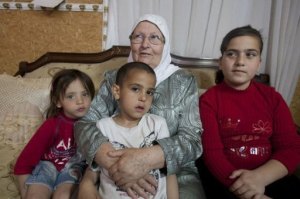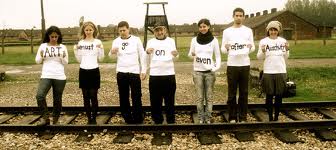Wishing all our readers a sweet and happy Rosh HaShanna. Shofar blowing by Jews around the world.
Happy New Year 2012 (5773)
Haredim Trying to Increase Control Over Area Around Jerusalem’s Central Shuk
Editor’s note: the HaAretz article mentioned below says the woman in question lived in Machane Israel, not Mahane Yehuda. We are currently inquiring from HaAretz if they indeed meant Machane Israel. Machane Israel is not even remotely a Haredi neighborhood. It contains two non-orthodox yeshivas: Hebrew Union College (Progressive/Reform) and the Conservative Yeshiva and two large centers housing visiting groups for the Progressive and Masorti movements. It also contains the YMCA (Young Men’s Christian Association), four hotels and one under development catering to business travellers and mainstream tourists. Women regularly walk through the area in pants and many HUC students rent apartments in the area.

Note posted on apartment door asking a religious (Masorti) woman to leave because she isn't modest according to the Torah.
According to a report in HaAretz, Masorti (Conservative) Jewish woman living near Mahane Yehuda, the main stall based shopping market in Jerusalem, was sent a threatening letter last week demanding she leave the neighborhood. The letter was signed “The Modesty Police” It complained that she had transgressed the Torah’s rules of modesty.
The woman says she moved into the neighborhood because she needed a place to stay after she returned from America. She did not know that the neighborhood was predominantly Haredi. She also says that she gets along well with her neighbors, and was not aware of problems. She says she wears pants but does not wear short ones.
Police have said they will step up surveillance in the area, but the woman is still afraid. A friend of hers who ignored the warning had her apartment burned down.
The area around Mahane Yehuda is culturally diverse and includes haredim, hippies, and middle class professionals attracted to an area with a lot of character and ripe for renovation projects. There are many different styles of Jewish religious life, both Sephardi and Ashkenazi, progressive and traditional.
Haredim in the area have been trying to extend their control over the area. For several years the Kolben Dance Troupe had covered their rehearsal room with shades because of Haredi complaints about the women dancers. The Dance Troupe is on a main road leading out of the main Jerusalem commercial area and is in no way Haredi. It is part of a complex that includes a public library and one of Jerusalem’s major performing arts venues. However, there is a residential cluster of Haredim one to two blocks away off of the main road.
Haredim have also complained about entertainment in the Mahane Yehuda shuk. The city government has been hosting street festivals in the area for the last few years. Haredim dislike that women are included in the performances, seeing it as a violation of their understanding of Jewish modesty. They have threatened to set up their own strictly gender seggregated shuk.
Most Jews, including religious Jews, do not consider the Haredi understanding of gender segregation to be required by the Torah, nor even later Jewish law nor identity.
Hat tip: Failed Messiah
Neshama Carlebach’s Inclusive HaTikva
At the invitation of the Forward, Neshama Carlebach has recorded a new version of the first verse of HaTikva, Israel’s national anthem.
The Forward’s goal was to start a debate about how the wording of HaTikvah could be made more inclusive for Arab Israelis by setting new words to the prayerful voice of Neshama Carlebach. The lack of inclusiveness made headlines earlier this spring when an Arab Israeli Supreme Court judge, Salim Joubran, stood for the anthem but did not sing the words aloud.
The lyrics are a joint effort of Forward blogger Philologos and Neshama Carlebach. Philologos made suggestions for replacing several phrases that excluded non-Jewish Israelis. Carlebach added a repeat of the last two lines of HaTikva using the original words. Thus the inclusion of non-Jewish Israelis wouldn’t be at the expense of the Jewish Israeli experience.
Here are the revised lyrics. Changes are in bold with the original words following in brackets.
As long as the heart within
An Israeli [Jewish] soul still yearns
And onward, towards the East
An eye still gazes towards our country [Zion]
We have still not lost our hope
our ancient [2000 year] hope
To be a free people in the land of our fathers [our land]
in the city in which David, in which David encamped [land of Zion and Jerusalem]
To be a free people in our land
In the land of Zion and Jerusalem
For Philologos, these lyrics represent a change of heart. Back in 1998 when Israel made it to the World Cup, the anthem had also made the news. One of the Israeli team members, an Arab Israeli named Walid Badir, also stood but stayed silent. At that time Philologos had believed that there was nothing that could be done to make the words acceptable and people like Badir would just have to settle with standing and staying silent. This spring, after the Joubran story made headlines, he wrote,
I’ve changed my mind about “Hatikvah.” The successful integration of Israeli Arabs into Israeli life, on which the country’s future depends, has to have its symbolic expression, too. It’s unacceptable to have an anthem that can’t be sung by 20% of a population. Permitting it to stand mutely while others sing is no solution.
Neshama Carlebach is very aware of the sensitive nature of the song. As she explained to the Jerusalem Post,
I think it was a very controversial move, because to change the lyrics to a precious song like ‘Hatikva’ is a very big statement… It’s not about leaving the world we were in behind; it’s about opening our doors wider. I feel that if the world sees, in my own humble opinion, that Israel is not just a small exclusive group that they can’t touch, but a larger entity that’s willing to wrap our arms around the whole of humanity or even change our anthem, we’re opening our doors, and maybe the press would be better.
Ynet Joins JPost for Jerusalem Bus Ad Fight Blooper Award
 Ynet wins this month’s award for completely inappropriate pictures of women. Today, Ynet posted an update on the campaign to show the faces of modestly dressed Jerusalem women on Jerusalem bus ads. The picture accompanying the article shows the bottom half of a woman’s body (no face) and is focused on her crotch.
Ynet wins this month’s award for completely inappropriate pictures of women. Today, Ynet posted an update on the campaign to show the faces of modestly dressed Jerusalem women on Jerusalem bus ads. The picture accompanying the article shows the bottom half of a woman’s body (no face) and is focused on her crotch.
This is not a fight about advertisers wanting to put sexy women on buses, but rather a fight over whether serious public service advertisements including women can be displayed. The matter goes back to 2008 when Egged refused campaign advertisements that featured the face of Rachel Azaria, running for city council as head of the newly formed Yerusalmim party. They told her ‘No pictures of girls on buses in Jerusalem. Not a 3-year-old and not an 80-year-old.”
The battle heated up again last fall when Egged refused to display women on posters for a public service campaign to increase organ donors. Once again the pictures showed only faces. There were no exposed shoulders or any other form of provocative dress. None the less, Egged’s advertising agency asked the National Transplant Center (ADI), to replace the advertisements with ones showing only men. The advertising agency explained that a 2007 campaign which showed an organ donor and her son had been vandalized and the bus set on fire.
In November, Yerushalmim tried to place posters of the faces of women living in Jerusalem on buses. The campaign was titled “Women of Jerusalem, Nice to Meet You”. The women were fully dressed in “regular, completely modest, unrevealing and unoffending clothes.” None the less, they were told that they would have to deposit 50,000 NIS for any damages to the buses caused by the posters.
In December, Yerushalmim and several Jerusalem residents took the matter to the Supreme Court. This most recent article describes the Supreme Court’s request to the government to clarify two questions:
- “why it [the government ] does not stipulate that licenses for operating public transportation will only be issued to companies that avoid activities that may include gender-based discrimination. “
- “why it [the government] does not impose real sanctions on Egged when it goes against basic constitutional principles”
This is not the first time an update to this story has been posted with an inappropriate picture. At the beginning of March, the Jerusalem Post selected a picture of a woman licking a plate to accompany the article.
Jacob’s Bones asked Ynet how it chose the picture. Ynet explained:
In this case, I assume we can both agree the photo used is that of a woman, and it very much looks like an ad. As such, it seems at least partly relevant to the story, and certainly to the story’s headline. I think that’s good enough.
Were there really no pictures that looked like a woman, looked like an ad, and showed her face? What about a breast cancer awareness ad? Or the ADI organ donation ad featuring a woman that was rejected from Jerusalem buses? Or one of the rejected pictures from the Yerushalmim campaign that triggered the supreme court case?
As unimaginable and as crazy as it sounds, the Haredim here aren’t complaining about sexy Jeans advertisements. That might be understandable.
They are complaining and sometimes vandalizing buses with fully clothed women doing public service announcements. What has women in Jerusalem upset is that even modest practical pictures of women can’t get on buses.
Haredim claim that women should not be displayed on buses because a picture of a woman is inherently sexual. Picture selections like these only serve to reinforce social attitudes that women in the media equals sex in the media.
Israel Celebrates Earth Day: North, South, East and West
 On Sunday, April 22, 2012, Israel celebrated Earth Day with events from southern most Eilat to northernmost Acco, from coastal Tel Aviv to Jerusalem on the edge of the West Bank, from the Negev to the Galilee.
On Sunday, April 22, 2012, Israel celebrated Earth Day with events from southern most Eilat to northernmost Acco, from coastal Tel Aviv to Jerusalem on the edge of the West Bank, from the Negev to the Galilee.
The days events cumulated with an hour long rolling “lights out” in 23 cities across Irael, including the capital Jerusalem. The cities were divided into four groups turning off their lights in ten minute intervals at 8:00, 8:10, 8:20, and finally 8:30. The IDF also turned out the lights on all bases for one hour starting at 8:00pm. The Israel Electric Company (IEC) reported that during the half hour where all 23 cities had their lights partially or fully out, nationwide electricity usage dropped by 35%.
The hour long black out was inspired by “Earth Hour”. Earth Hour aims to build global awareness about energy conservation and green energy sources through a global “lights out” starting around 8:30PM local time around the world. The event normally happens the last Saturday of March. Shabbat observant members would find it difficult to participate because Shabbat ends just before 8PM around that time of year. In order to include both religious and non-religious environmental advocates, Israel usually reschedules its participation. Last year it marked Earth Hour on Thursday, March 24 two days before the global Earth Hour on March 26. This year it postponed Earth Hour until Earth Day.
The Israel Electric Company (IEC) gave prominent billing to the event on its home page and also dedicated several pages on its website to encourage participation.
Colonel Ronen Marley, commander of an IDF training school in the Negev, said that love of Israel’s land and its defense cannot be separated:
Those who don’t love the land, the earth, cannot protect it. When we educate our squad commanders to care for nature, the result is that they will pay attention to the environment during military operations and minimize the damage caused by these activities, and we will increase their sense of responsibility,
Taiku! Israeli Masorti Movement Opens Door to Gay Rabbis
 Taiku! This is the word the Talmud uses when a debate simply can’t be resolved. Rather than pick one solution the Talmud cries Taiku! Tie! Let it stand! and the parties go onto other issues. We like to think that there is one right way and if people work hard enough they will find it. In reality there were many many times when the Talmud could find no way to resolve a dispute. Forcing a solution only divides a community. Calling “Taiku!” allows the community to stay together even without exact agreement on every issue.
Taiku! This is the word the Talmud uses when a debate simply can’t be resolved. Rather than pick one solution the Talmud cries Taiku! Tie! Let it stand! and the parties go onto other issues. We like to think that there is one right way and if people work hard enough they will find it. In reality there were many many times when the Talmud could find no way to resolve a dispute. Forcing a solution only divides a community. Calling “Taiku!” allows the community to stay together even without exact agreement on every issue.
Two Contradictory Opinions
The Conservative movement’s handling of gay unions and ordinations is a modern day example of “Taiku!”. In 2006 the Conservative Movement’s Committee on Jewish Law and Standards (CJLS) took up the issue of the status of homosexuality within Conservative Jewish Halachah. Given the strong feelings on all sides, there was no way to come to a single answer, so the committee accepted two contradictory rulings.
The first of these opinions ( EH 24.2006a ) , by Joel Roth, argued against gay unions and ordinations. Roth was concerned that wholesale rejection of rabbinic bans against homosexual relatinships would put the Conservative movement too far outside the bounds of the halachic community which includes orthodox Jews and not just conservative Jews. Continue reading
Eisner and the Activists: What Really Happened on Saturday at Route 90?
Within a week it had almost 600,000 hits. The video, released on YouTube a week ago, showed IDF soldier Shlomo Eisner striking a young distracted Danish man in the face with the long side of his M16 on Saturday afternoon (April 14, 2012).
After a flurry of articles including two New York Times articles (April 17, April 18), it looked like the story would die down. But on Friday B’Tselem released a new video filmed by Palestinian TV. The video shows Eisner hitting an additional 4 people, one in the back with his gun. Another person struck by Eisner was standing still in front of Eisner. In order to strike her Eisner had to take at least one pace forward and lunge.
Eisner had claimed that he was acting in self defense after having already been attacked. He said the first video had been heavily edited. It presented a distorted picture of what happened. The so-called cyclists were anarchists. For Eisner to have acted in any other way would have put lives at risk. Continue reading
A Tale of Three Religions: a Muslim Israeli Holocaust Survivor

Leila Jabarin (nee Helen Brashatsky) with her grandchildren. credits: AFB (click picture for and additional photos).
A set of distinctly Eastern European eyes peers out from under the white hijab. Although the woman is Muslim, she was born in Auschwitz.
When Helen Brashatsky’s parents and two brothers arrived in Auschwitz in 1941, Helen’s mother was pregnant. Pregnant women were usually killed, but Helen’s mother was lucky. A Christian doctor hid Helen’s family under the floor of his house inside the Auschwitz compound. When she was born, he hid her in a pile of bath towels. During the day, Helen’s mother did the doctor’s housework and her father was the gardener. At night the parents would return to the doctors house and feed the children bread soaked in salt water. After WWII the family immigrated to Israel and settled in Ramat Gan.
Helen was six when her family came to Israel, a few months before statehood was declared. She grew up in Ramat Gan, but at 17 she fell in love with an Arab man. Much to her parents’ dismay she ran away to marry him and live in his village. Eventually after two years she and her family reconciled.
Even though she married an Arab man, she remained Jewish and did not convert to Islam. But when her children began approaching army age, she became concerned that her daughter would not be accepted in the community where she grew up if she had to serve in the army. By converting she could prevent her children from being drafted and so she did.
Helen never told her husband and children about her Holocaust story. For years she would cry alone on Holocaust memorial day, much to the confusion of her family. She says “There are no words to describe the pain that I feel. How can children eat dry bread soaked in water? If this happened to my children, I don’t know what would become of me.”
She says she was waiting for the right moment. That moment came when a man from Israeli social services showed up to ask about her past. Her oldest son, now 33, says that it answered a lot of questions “Mum used to cry on Holocaust Memorial Day watching all the ceremonies on Israeli television. We never understood why. We all used to get out of the way and leave her alone in the house…We understand her a bit more now.”
For more about Leila’s story: Holocaust survivor finds haven as Muslim in Israel , Your Middle East (AFP), April 18, 2012.
Turning No into Yes

Adam Kohn and grandchildren holding signs saying "Art must go on even after Auschwitz" . Adam Kohn's family visited Auschwitz in 2010. They produced a video of the family dancing to "I will survive" in front of a synagogue, and three concentration camps. Click photo to see video.
Picking up on Eli Weisel’s observation that he has spent his entire life trying to turn “No” into “Yes”, Joshua Hammerman discusses why remembering tragedy is only half the story of Holocaust remembrance:
If the message is survival for its own sake, it is not a survival that is well-rooted. Ultimately, that message won’t be enough, unless it is accompanied by the joyous refrain, “Shiru l’Adonai shir hadash,” “Sing unto the Lord a New Song.” And that is why “Never again” is also not enough.
… The Holocaust can be a spark of Jewish identity and even Jewish pride, but it is not enough to ensure another generation of Jews
…. When I see the hundreds of millions of dollars that have been raised for scores of Holocaust memorials and research centers in America, it doesn’t bother me at all. The memory must remain fresh. The world needs to know; our children need to know and take pride in their heritage, even as regarding Auschwitz
….But there must be a matching grant. The same amount of money must be poured into Jewish education, synagogues and day schools, into making affiliation affordable for every young family, and into programs that emphasize joy rather than victimization. It should not and cannot be one or the other; it must be one and the other…. Auschwitz will reside at the core of the next generation’s Judaism, but we must understand this — the Holocaust will be reinterpreted. The facts will remain the same — they must — but the lessons will change. Just as the exodus from Egypt must be reinterpreted “b’hol dor v’dor” (in every generation) so will the Shoah. It is hard to imagine discussing these events with fewer tears, but they will. It is hard to imagine the bitterness dissipating, but it will. It is hard to imagine anyone coming to reaffirm the joy of Judaism through these darkened binoculars, but they will.
For the full essay see The Times of Israel.
Holocaust, the Fourth Generation
I hope that you come to me
And tell me that you learned the word chronological
And that you put all the books on your book shelf in chronological order
And I hope that the diary of Anne Frank
Ends up ordered out of history between the dinosaur books and the caveman books…
I hope that you yell at me
and that you run to mommy, “Mommy, Daddy’s lying to me”….
I will patiently answer your “How?” and your eventual tearful “Why?”
You will bear witness, but I hope you resist
I hope that the world you live in is one that makes believing in the Shoah more difficult than believing in God….
The above poem is by Andrew Lustig, author and producer of the video “I am Jewish”.
Speaking about his video to the Times of Israel, he said:
Basically, I really hope that one day remembrance, regarding the Holocaust, can mean something different. I hope that my children can live in a world where they are so accepted and appreciated for who they are that the idea that anyone would hate them for it would be as unbelievable, at first, as if I told a child today that years ago people were hated and killed because they had hazel eyes, or dirty blond hair.

 RSS
RSS